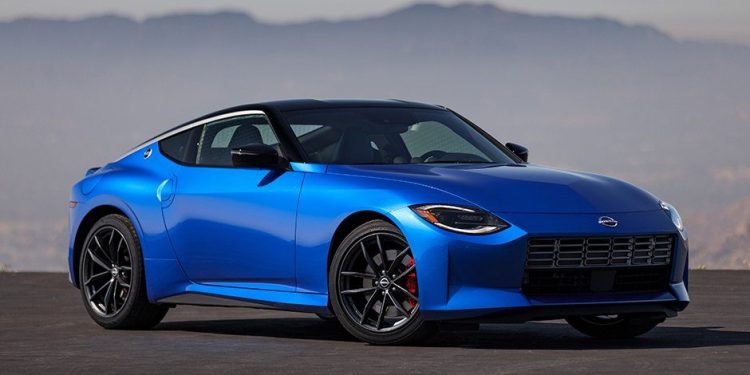This is it: Nissan Z finally revealed with 298kW twin-turbo V6
After years of rumour and speculation, with a high-profile tease or two thrown in for good measure, Nissan has finally dropped its new Z sports car in its full 2023 production-version glory; revealing its name, its powertrain, and a handful of minor changes since it was first shown off in prototype form.
Nissan has confirmed speculation that the model would not be called the 400Z. Instead it’s simply called the Nissan Z in western markets. It’s been reported that the model will be called the Fairlady in Japan, but this has yet to be confirmed by Nissan.

Under the bonnet is one of the world’s worst-kept secrets. As had been long rumoured, Nissan has given the Z its ‘VR30DDTT’ 3.0-litre twin-turbo V6, borrowed from the Infiniti Q50 Red Sport. It produces 298kW (400hp) of power at 6400rpm and 475Nm of torque at 1600-5600rpm, sending this output exclusively to the rear wheels.
The Z comes with either a close ratio six-speed manual or a nine-speed automatic. The former features a high-performance clutch supplied by Exedy, and it’s tipped that the latter is a torque-converted 9G-Tronic unit borrowed from Mercedes-Benz. Each unit is capable of automated rev-matching on downshifts, while the auto throws in launch control.

Nissan doesn’t quote a 0-100km/h time, stating only that the Z will hit 100km/h around 15 per cent faster than the outgoing 370Z. Given the 370Z performs this feat in around 5.3 seconds, the Z should be able to topple the ton in about 4.5 seconds.
Two trim levels have been confirmed for the North American market; the entry-level Sport and the flagship Performance. The latter features an unchanged powertrain, but gets a raft of other performance and luxury goodies.
Chief among these is the inclusion of launch control on manual models (launch control only being available in the automatic Z Sport), which is a first for a rear-driven Nissan. The Performance’s six-speed is a trick unit, also packing SynchroRev Match. Automatic Performance grades get aluminium paddles, too.

The Nissan Z Performance also adds a mechanical limited-slip differential, larger brakes, forged 19-inch wheels sourced from Rays, dual exhaust, and a mild front and rear spoiler duo. Inside, the premium grade also gains leather upholstery, a larger 9-inch infotainment screen, 8-speaker Bose audio, WiFi, sport pedals, heated and power-operated seats, and more.
While the Nissan Z had yet to be confirmed for the New Zealand market, we expect an announcement is imminent. We also expect that the Performance grade will be the main model heading our way.
On top of these two trims, Nissan has also unveiled a limited edition model for the North American market called the Proto Spec. As the name suggests, it’s a homage to the Z’s prototype, coming with the same assortment of yellow highlights, bronze 19-inch Rays wheels, and a handful of other trinkets like an exclusive gear knob (they’re exclusively six-speed manuals). Just 240 are going to be produced, the number being a nod to the Nissan 240Z.

“Simply put, our goal is to make this the best Z yet, period. With each generation, we raise the bar, pushing the limits of Z and continuing to tap into the human instinct for that next thrilling journey,” said Hiroshi Tamura, chief product specialist of the new Z. “More than just powerful and agile, the 2023 Z is designed to be one with the driver for all kinds of on-road adventures.”
In terms of design, the Z looks almost identical to the Proto Z from last year. The grille now features a sensor unit, there’s a wee keyhole next to the Z badge on the bootlid, and the bold painted tyres have been replaced by standard Yokohama Advan Sport or staggered Bridgestone Potenza S007 rubber, depending on the spec you get.
Other than that, the proportions, lines, and features of the Nissan Z’s design are unchanged. While the squared-off grille has its doubters, the model is likely to be well received among Nissan faithful.

Perhaps the most interesting question of the new Z is whether it is in fact an ‘all-new’ car. Nissan states as much in its press release, but it’s clear that the model is at least partially based on the platform of the outgoing 370Z. Eagle-eyed punters will note that the door cards in the interior are a carryover part from the 370Z.
This appears to be confirmed in the Nissan Z’s dimensions. Its wheelbase is identical to the old 370Z, at 2550mm. It’s a little longer overall, at 4379mm, and a smidge slimmer and lower with a width of 1844mm and a height of 1315mm.
Still, Nissan has clearly put in some work with the Z’s underpinnings. It will be fascinating to get behind the wheel and see if it still walks a muscle-car walk. Nissan says it’s tuned the chassis to increase driver connection, boasting that it’s more rigid than before.

Beefed up monotube shock absorbers with a wider diameter bring a 20 per cent reduction in dampening force for a smoother ride and better control. The front-end double-wishbone suspension is formed from aluminium, has ‘new geometry’, and more castor angle. The rear multi-link set-up also gets a new calibration.
“Simply put, our goal is to make this the best Z yet, period. With each generation, we raise the bar, pushing the limits of Z and continuing to tap into the human instinct for that next thrilling journey,” said Hiroshi Tamura, chief product specialist of the new Z.
“More than just powerful and agile, the 2023 Z is designed to be one with the driver for all kinds of on-road adventures.”





